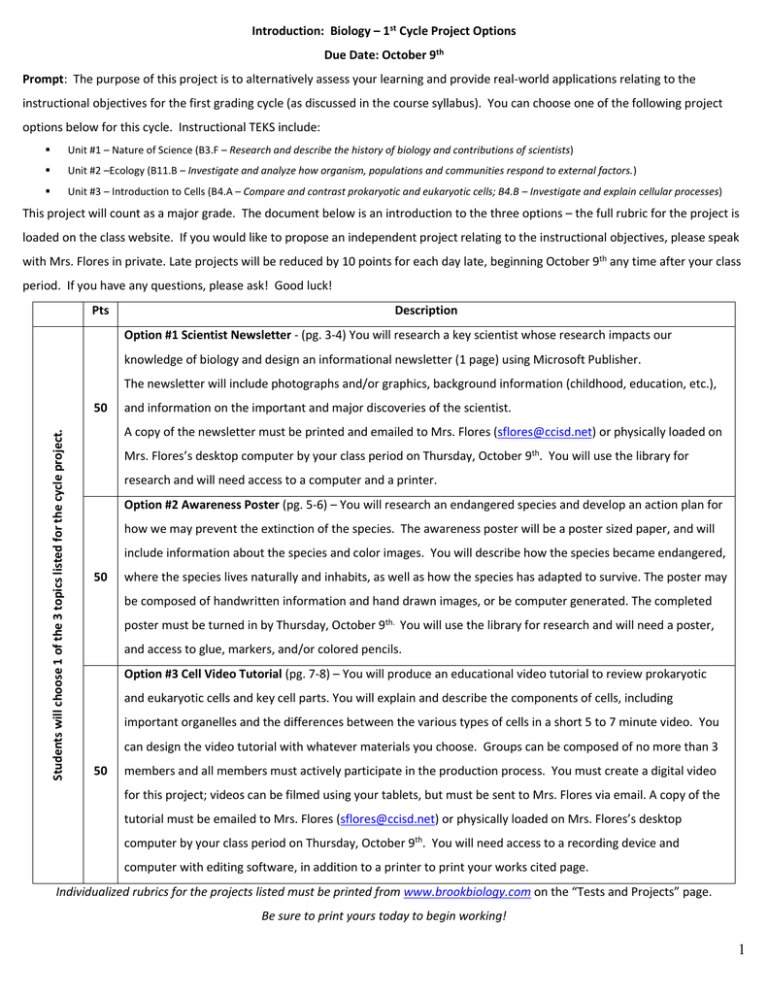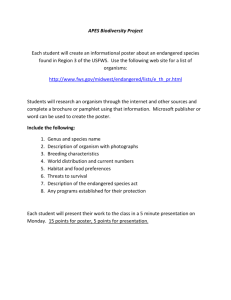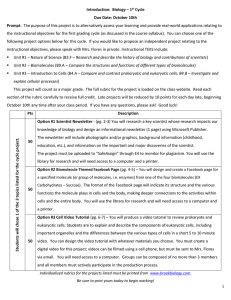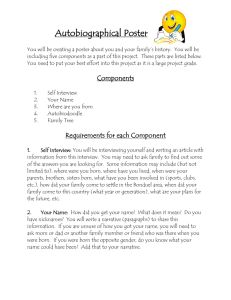Introduction: Biology – 1st Cycle Project Options Due Date: October
advertisement

Introduction: Biology – 1st Cycle Project Options Due Date: October 9th Prompt: The purpose of this project is to alternatively assess your learning and provide real-world applications relating to the instructional objectives for the first grading cycle (as discussed in the course syllabus). You can choose one of the following project options below for this cycle. Instructional TEKS include: Unit #1 – Nature of Science (B3.F – Research and describe the history of biology and contributions of scientists) Unit #2 –Ecology (B11.B – Investigate and analyze how organism, populations and communities respond to external factors.) Unit #3 – Introduction to Cells (B4.A – Compare and contrast prokaryotic and eukaryotic cells; B4.B – Investigate and explain cellular processes) This project will count as a major grade. The document below is an introduction to the three options – the full rubric for the project is loaded on the class website. If you would like to propose an independent project relating to the instructional objectives, please speak with Mrs. Flores in private. Late projects will be reduced by 10 points for each day late, beginning October 9th any time after your class period. If you have any questions, please ask! Good luck! Pts Description Option #1 Scientist Newsletter - (pg. 3-4) You will research a key scientist whose research impacts our knowledge of biology and design an informational newsletter (1 page) using Microsoft Publisher. The newsletter will include photographs and/or graphics, background information (childhood, education, etc.), Students will choose 1 of the 3 topics listed for the cycle project. 50 and information on the important and major discoveries of the scientist. A copy of the newsletter must be printed and emailed to Mrs. Flores (sflores@ccisd.net) or physically loaded on Mrs. Flores’s desktop computer by your class period on Thursday, October 9th. You will use the library for research and will need access to a computer and a printer. Option #2 Awareness Poster (pg. 5-6) – You will research an endangered species and develop an action plan for how we may prevent the extinction of the species. The awareness poster will be a poster sized paper, and will include information about the species and color images. You will describe how the species became endangered, 50 where the species lives naturally and inhabits, as well as how the species has adapted to survive. The poster may be composed of handwritten information and hand drawn images, or be computer generated. The completed poster must be turned in by Thursday, October 9th. You will use the library for research and will need a poster, and access to glue, markers, and/or colored pencils. Option #3 Cell Video Tutorial (pg. 7-8) – You will produce an educational video tutorial to review prokaryotic and eukaryotic cells and key cell parts. You will explain and describe the components of cells, including important organelles and the differences between the various types of cells in a short 5 to 7 minute video. You can design the video tutorial with whatever materials you choose. Groups can be composed of no more than 3 50 members and all members must actively participate in the production process. You must create a digital video for this project; videos can be filmed using your tablets, but must be sent to Mrs. Flores via email. A copy of the tutorial must be emailed to Mrs. Flores (sflores@ccisd.net) or physically loaded on Mrs. Flores’s desktop computer by your class period on Thursday, October 9th. You will need access to a recording device and computer with editing software, in addition to a printer to print your works cited page. Individualized rubrics for the projects listed must be printed from www.brookbiology.com on the “Tests and Projects” page. Be sure to print yours today to begin working! 1 This calendar lists the tutorial days Mon prior to the due date for the September 2014 Wed Tue Thu 11 project. If at any time you need Fri 12 Projects Introduced! assistance with your project, please CBHS Library Introduction come to tutorials! 15 16 17 18 19 Project Option Query! PM Tutorial Day! 22 23 29 PM Tutorial Day! 30 Option #2 Deadline – Identify the Species! 6 PM Tutorial Day! 24 25 26 PM Tutorial Day! 1 2 No School PM Tutorial Day! 7 PM Tutorial Day! 8 9 10 Projects Due! Option #3 Presentations Additional Resources PM Tutorial Day! Special PM Tutorial Day! Scientists http://www.eiu.edu/wism/about_biographies.php http://www.famousscientists.org/ http://www.sciencechannel.com/famous-scientists-discoveries Endangered Species http://www.fws.gov/endangered/ http://www.iucnredlist.org/ https://worldwildlife.org/species/directory?direction=desc&sort=extinction_status Cells http://www.wiley.com/college/boyer/0470003790/animations/cell_structure/cell_structure.htm http://www.projectsharetexas.org/resource/prokaryotic-and-eukaryotic-cells-structure-and-function-cells http://learn.genetics.utah.edu/content/cells/insideacell/ 2 Name ____________________________________________________ Per ___ 1st Cycle Biology Grading Rubric: Option #1 – Scientist Newsletter Due Date: October 9th Prompt: The purpose of this project is to alternatively assess your learning and provide real-world applications relating to the instructional objectives for the first grading cycle. You will research a key scientist whose research impacts our knowledge of biology and design an informational newsletter (1 page) using Microsoft Publisher. The newsletter will include photographs and/or graphics, background information (childhood, education, etc.), and information on the important and major discoveries of the scientist. A copy of the newsletter must be printed and emailed to Mrs. Flores (sflores@ccisd.net) or physically loaded on Mrs. Flores’s desktop computer by your class period on Thursday, October 9th. You will use the library for research and will need access to a computer and a printer. This project will count as a major grade. Read each section of the rubric carefully to receive full credit. Late projects will be reduced by 10 points for each day late, beginning October 9th period any time after your class period. If you have any questions, please ask! Good luck! You will draw for one of the following: - Anton van Leeuwenhoek (Cell theory, Protists) - J. Craig Venter (Gene Sequencing) - Barbara McClintock (Genetics) - Jan Ingenhousz (Photosynthesis) - Charles Darwin (Evolution) - Jane Goodall (Primates) - Daniel Nathans & Hamilton Smith (restriction - Linus Pauling (Biochemistry) enzymes) - Lynn Margulis (Organelles) - David Baltimore (Reverse transcriptase) - Matthias Schleiden (Cell theory, Plants) - Diane Fossey (Primates) - Robert Brown (Nucleus) - Ernest Everett Just (Cells) - Robert Hooke (Cell theory, Cork) - Erwin Chargaff (Biochemistry) - Robert Koch (Bacteria) - Francis Crick & James Watson (DNA) - Rosalind Franklin (DNA) - Frederick Sanger (Genetic Code) - Rudolf Vichow (Cell theory) - George Beadle & Edward Lawrie Tatum (Enzymes) - Theodor Schwann (Cell theory, Animals) - Gregor Mendel (Genetics) - Thomas Hunt Morgan (Genes) Pts Description Received Comments Sources - You are to use at least 3 sources – either print or from CCISD’s online 6 resources; Gale, Facts on File, Science Online, etc. Each source should be identified in an MLA citation [see below]. Works Cited - You will identify sources within a works cited page, printed and Research attached to the rubric; all information presented in the newsletter needs to be cited. Students may NOT cite information posted on Wikipedia, Wiki-answers, Google, Ask.com, and/or Yahoo! Answers or other, non-academic website. 4 You may use the website Son of Citation Machine, EasyBib, or another site to format the works cited. The list should be formatted according to MLA guidelines such as: Double Spaced; alphabetized; hanging indention, etc. For more information, visit the Clear Brook librarian or access the Purdue Online Writing Lab @ http://owl.english.purdue.edu/owl/resource/747/05/. 3 Writing The newsletter will be written in complete sentences and be free of grammatical errors. It will communicate the information to others with the 5 specific purpose of educating others. You are to include effective introductory and concluding paragraphs and a variety of sentence structures. Overall, the newsletter will show sufficient time and effort. You will create a headline and write an article about the scientist(s) whose Articles & Vocabulary inventions and/or discoveries contributed to biology. 20 Include background information on the scientist(s) o Childhood, education, etc. Important and major discoveries, achievements that relate to biology You will create a headline and write a secondary article relating somehow the 6 first articles topic of discussion. EX Main Article: Albert Einstein; Secondary Article: Germany [his country of birth] Students will identify underline new and useful vocabulary words from the 5 articles (at least 5; they need not be scientific) and define them in a separate section of the newsletter. Graphics & Hyperlinks At least 2 pictures and/or graphics should be added to the newsletter; each must identify the website of origin beneath the image and be hyperlinked. To hyperlink a picture: 1. 2. 3. 4. 5. 4 Highlight the picture Right click Click “hyperlink…” Paste the website URL address in the address bar Press “ok” No credit will be awarded without the website URL caption and a hyperlink. 50 Total General Comments 4 Name ____________________________________________________ Biology Grading Rubric: 1st Per ___ Cycle Option #2 – Awareness Poster Prompt: The purpose of this project is to alternatively assess your learning and provide real-world applications relating to the instructional objectives for the first grading cycle. You will research an endangered species and develop an action plan for how we may prevent the extinction of the species. The awareness poster will be poster sized paper, and will include information about the species and color images. You will describe how the species became endangered, where the species lives naturally and in habitats, as well as how the species has adapted to survive. The poster may be composed of handwritten information and hand drawn images, or be computer generated. The completed poster must be turned in by Thursday, October 9 th. You will use the library for research and will need a poster, and access to glue, markers, and/or colored pencils. This project will count as a major grade. Read each section of the rubric carefully to receive full credit. Late projects will be reduced by 10 points for each day late, beginning October 9th period any time after your class period. If you have any questions, please ask! Good luck! Pts Description Received Comments Preparation Selecting an Organism – 3 Find an endangered organism that interests you from the approved list from www.iucnredlist.org. Clear the organism with your teacher (at tutorials or via email sflores@ccisd.net) by September 29th; there can only be one of each organism per class. Sources - You are to use at least 3 sources – either print or from CCISD’s 6 online resources; Gale, Facts on File, Science Online, etc. Each source should be identified in an MLA citation [see below]. Works Cited - You will identify sources within a works cited page, printed and attached to the rubric; all information presented in the poster needs Research to be cited. Students may NOT cite information posted on Wikipedia, Wiki-answers, Google, Ask.com, and/or Yahoo! Answers or other, nonacademic website. 4 You may use the website Son of Citation Machine, EasyBib, or another site to format the works cited. The list should be formatted according to MLA guidelines such as: Double Spaced; alphabetized; hanging indention, etc. For more information, visit the Clear Brook librarian or access the Purdue Online Writing Lab @ http://owl.english.purdue.edu/owl/resource/747/05/. Writing The poster will be written in complete sentences and be free of grammatical errors. It will communicate the information to others with 5 the specific purpose of educating others. You are to well-written paragraphs and a variety of sentence structures. Overall, the poster will show sufficient time and effort. 5 You will create an awareness poster about one endangered species currently alive on Earth. Include background information o Description of natural habitat and map, image of Poster & Vocabulary species, how the species became endangered, data on the species 23 Include an action plan on what people can do to increase species’ numbers and prevent extinction. Include information about the adaptations that the species has made in order to survive, or about adaptations that need to occur in order for the species to survive. Include information about where the species may be found outside of its natural habitat (in a zoo, research facility, conservation land, etc.) Students will identify underline new and useful vocabulary words from 5 the awareness poster (at least 5; they need not be scientific) and define them in a separate section of the poster. Graphics At least 2 pictures and/or maps should be added to the poster; if not 4 drawn by hand, each must identify the website of origin beneath the image. No credit will be awarded without the website hyperlink URL caption. 50 Total General Comments 6 Name ____________________________________________________ Biology Grading Rubric: 1st Per ___ Cycle Option #3 - Video Tutorial Due Date: October 9th Prompt: You will produce an educational video tutorial to review prokaryote and eukaryotic cells and key cell parts. You will to explain and describe the components of cells, including important organelles and the differences between the various types of cells in a short 5 to 7 minute video. You can design the video tutorial with whatever materials you choose. Groups can be composed of no more than 3 members and all members must actively participate in the production process. You must create a digital video for this project; videos can be filmed using your tablets, but must be sent to Mrs. Flores via email. A copy of the tutorial must be emailed to Mrs. Flores (sflores@ccisd.net) or physically loaded on Mrs. Flores’s desktop computer by your class period on Thursday, October 9 th. This project will count as a major grade. Read each section of the rubric carefully to receive full credit. Late projects will be reduced by 10 points for each day late, beginning October 9th period any time after your class period. If you have any questions, please ask! Good luck! Pts Description Received Comments Sources - You are to use at least 3 sources – either print or from CCISD’s 6 online resources; Gale, Facts on File, Science Online, etc. Each source should be identified in an MLA citation [see below]. Works Cited - You will identify sources within a works cited page, printed and attached to the rubric; all information presented in the newsletter Research needs to be cited. Students may NOT cite information posted on Wikipedia, Wiki-answers, Google, Ask.com, and/or Yahoo! Answers or other, non-academic website. 4 You may use the website Son of Citation Machine, EasyBib, or another site to format the works cited. The list should be formatted according to MLA guidelines such as: Double Spaced; alphabetized; hanging indention, etc. For more information, visit the Clear Brook librarian or access the Purdue Online Writing Lab @ http://owl.english.purdue.edu/owl/resource/747/05/. Introduction - The students will describe the following in a segment Introduction titled “Introduction”. You will introduction yourself and introduce the tutorial. 9 Students MUST explain the following: Explain the history of cell theory Explain the basic structure of a cell Identify the similarities/differences between prokaryotes and eukaryotes 7 Organelles - The students will describe the following in a segment titled “Organelles and Processes”. Organelles Students are to identify organelles and the important processes relating to them. Students MUST explain the following: 15 Cell Wall Chloroplasts Cytoplasm Mitochondria Nucleus Plasma Membrane Ribosome Visuals Visuals - You will include at least 3 visuals to include diagrams, posters, drawings, and/or models that explain the concepts in the tutorial. 6 The visuals must be large enough to be seen in the video and useful to the segments in the tutorial. Performance - Script will be clearly performed and confidently presented by all group members. 5 Performance All participants will display mastery of topic through spoken expression and proper preparation (a history of practice). Overall, you will understand the difference between prokaryotic cells and eukaryotic cells and show knowledge of the processes that occur 5 within eukaryotic cells. The explanation should be informative, but creative. The tutorial will communicate information to others with the specific purpose of educating others. 50 Total Peer Evaluations: Avg ______ General Comments 8 The list below is to be used for assignment purposes – students will identify the project they want, and, if they choose option #1, they will draw a number to match with their topic. 1. Anton van Leeuwenhoek (Cell theory, Protists) 2. Barbara McClintock (Genetics) 3. Charles Darwin (Evolution) 4. Daniel Nathans & Hamilton Smith (restriction enzymes) 5. David Baltimore (Reverse transcriptase) 6. Diane Fossey (Primates) 7. Ernest Everett Just (Cells) 8. Erwin Chargaff (Biochemistry) 9. Francis Crick & James Watson (DNA) 10. Frederick Sanger (Genetic Code) 11. George Beadle & Edward Lawrie Tatum (Enzymes) 12. Gregor Mendel (Genetics) 13. J. Craig Venter (Gene Sequencing) 14. Jan Ingenhousz (Photosynthesis) 15. Jane Goodall (Primates) 16. Linus Pauling (Biochemistry) 17. Lynn Margulis (Organelles) 18. Matthias Schleiden (Cell theory, Plants) 19. Robert Brown (Nucleus) 20. Robert Hooke (Cell theory, Cork) 21. Robert Koch (Bacteria) 22. Rosalind Franklin (DNA) 23. Rudolf Vichow (Cell theory) 24. Theodor Schwann (Cell theory, Animals) 25. Thomas Hunt Morgan (Genes) The list below is to be used for assignment purposes – students will identify the project they want, and, if they choose option #2, they are to clear their topic with you by Sept 29th. Name _________________________________________ Species __________________________ Date _________ Name _________________________________________ Species __________________________ Date _________ Name _________________________________________ Species __________________________ Date _________ Name _________________________________________ Species __________________________ Date _________ Name _________________________________________ Species __________________________ Date _________ Name _________________________________________ Species __________________________ Date _________ Name _________________________________________ Species __________________________ Date _________ Name _________________________________________ Species __________________________ Date _________ Name _________________________________________ Species __________________________ Date _________ Name _________________________________________ Species __________________________ Date _________ Name _________________________________________ Species __________________________ Date _________ Name _________________________________________ Species __________________________ Date _________ Name _________________________________________ Species __________________________ Date _________ Name _________________________________________ Species __________________________ Date _________ 9







